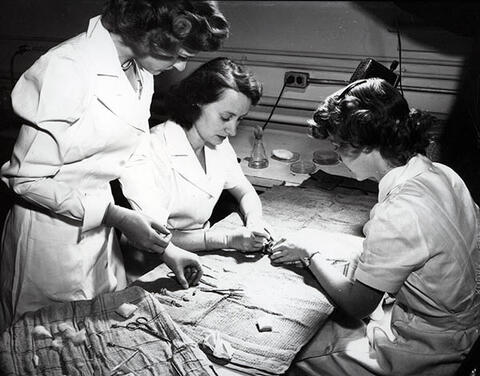
Área de título y declaración de responsabilidad
Título apropiado
Dr. Althea N. Burton, I. Wynn and [Helen] Rublee - Encephalomyelitis Research
Tipo general de material
- Graphic material
Título paralelo
Otra información de título
Título declaración de responsabilidad
Título notas
Nivel de descripción
Item
Institución archivística
Código de referencia
Área de edición
Declaración de edición
Declaración de responsabilidad de edición
Área de detalles específicos de la clase de material
Mención de la escala (cartográfica)
Mención de proyección (cartográfica)
Mención de coordenadas (cartográfica)
Mención de la escala (arquitectónica)
Jurisdicción de emisión y denominación (filatélico)
Área de fechas de creación
Fecha(s)
-
Apr. 1948 (Criação)
Área de descripción física
Descripción física
1 photograph : b&w ; 9 x 12 cm
Área de series editoriales
Título apropiado de las series del editor
Títulos paralelos de serie editorial
Otra información de título de las series editoriales
Declaración de responsabilidad relativa a las series editoriales
Numeración dentro de la serie editorial
Nota en las series editoriales
Área de descripción del archivo
Nombre del productor
Historial de custodia
Alcance y contenido
Dr. Althea N. Burton (centre), veterinary surgeon, working with I. Wynn (at Dr. Burton’s left) and [Helen]. Rublee (right), laboratory technicians, to transfer a virus to a live guinea pig.
Bio/Historical Note from news clipping: “Part of the technique of producing vaccine for encephalomyelitis or “sleeping sickness” in horses is shown here. Dr. Althea N. Burton (second from left), veterinary surgeon at the university’s animal diseases laboratory, is transferring a deadly virus obtained from the brain of a dead guinea pig to that of a live one. The animal’s skull has been anaesthetized and it feels no pain, and will die within four days. Laboratory technicians like I. Wynn (at Dr. Burton’s left) and H. Rublee (right), will remove the brain and place it in a glycerine preservative, keeping it there for a maximum of two weeks. The brain is then ground up and placed in a solution which is injected into an 11-day chicken embryo. Mamie C. Janzen (see A- 3643), is shown in this operation at far right. The egg shell is sealed with wax and incubated a further 24 hours, the length of time for the virus to kill the embryo. Removed from the shell and ground up in a “colloid mill”, formalin is added to the embryo to kill the virus. The vaccine is then filtered, diluted in saline solution, and stored for two weeks to ensure the death of the entire virus. In this form it is bottled and shipped to prairie druggist[s] from whom farmers buy it and inoculate their horses at a total cost of $1 per horse.” From Saskatoon Star-Phoenix, Apr. 1948.
Bio/Historical Note: In the mid-1940s Dr. J.S. Fulton and his research colleague, Dr. Althea N. Burton, modified the Western Equine Encephalitis Vaccine (WEE) so it could be used in humans. Burton initially worked as a technician in Fulton’s lab before completing her veterinary degree at the Ontario Veterinary College in 1947. After Fulton’s retirement in 1958, Burton continued the WEE studies in collaboration with other Saskatoon scientists — including professional and amateur entomologists. This collaborative team eventually confirmed that the WEE virus overwintered on the Prairies and was transmitted to birds, horses and humans through mosquito species. In 1966 the United States government granted $95,000 to a research team at the U of S for studies of western encephalitis. The grant, spread over three years, was made for research by Dr. Jacob G. Rempel, professor of Biology, and by Dr. Burton. Although research into the disease had been underway in Saskatchewan since the 1930s, the work was intensified with the announcement of the South Saskatchewan River Project and the Saskatoon team has produced results sufficiently impressive to attract international attention. More than 40 years later, findings from those foundational studies in WEE became invaluable as public health teams in Western Canada learned to deal with the spread of West Nile virus — another mosquito-borne arbovirus that affects birds, horses and humans.
Área de notas
Condiciones físicas
Origen del ingreso
Arreglo
Idioma del material
Escritura del material
Ubicación de los originales
Disponibilidad de otros formatos
Restricciones de acceso
Condiciones de uso, reproducción, y publicación
Photographer: Saskatoon Star-Phoenix
Copyright: University of Saskatchewan
Instrumentos de descripción
Materiales asociados
Acumulaciones
Nota general
See A-3643 for second image of series.

